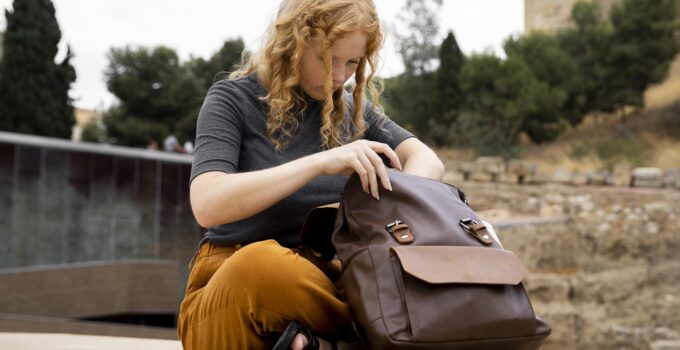Why to waterprof a canavs camera bag?
Waterproofing a canvas camera bag is essential to protect your valuable camera equipment from moisture, which can cause significant damage.
Canvas, while durable and stylish, is typically not inherently waterproof. By applying a waterproofing treatment, you create a barrier that prevents water from seeping through the fabric.
This is crucial when you’re out in unpredictable weather conditions or near water bodies where splashes are common.
Here, 10 best crumpler camera bag?
Moreover, waterproofing extends the lifespan of your camera bag by shielding it from stains, mold, and mildew that moisture can cause over time. It also adds an extra layer of protection against accidental spills or unexpected rain showers, providing peace of mind during outdoor shoots or travel.
Additionally, some waterproofing treatments offer UV protection, which helps maintain the color and integrity of the canvas fabric under sun exposure.
This ensures that your camera bag not only remains functional but also looks good for years to come, making waterproofing a practical investment in preserving both your gear and its carrying vessel.
Is it important to waterproof a canvas camera bag?
How to Waterproof a Canvas Camera Bag?
Is it worth to waterproof a canvas camera bag?
To waterproof a canvas camera bag, follow these steps:

- Clean the Bag: Start with a clean canvas bag by brushing off any dirt or debris. Use a mild detergent and water solution to spot clean if necessary. Allow the bag to dry completely.
- Choose a Waterproofing Product: Select a waterproofing treatment suitable for canvas. Options include silicone sprays, wax treatments, or specialized canvas waterproofing solutions.
- Apply the Waterproofing Treatment: Follow the manufacturer’s instructions for the chosen product. Typically, this involves spraying evenly over the entire surface of the bag or applying wax with a cloth, ensuring complete coverage.
- Allow to Dry: Let the bag dry thoroughly according to the product’s recommendations. This allows the waterproofing agent to bond effectively with the canvas fibers.
- Reapply as Needed: Depending on use and exposure to moisture, reapply the waterproofing treatment periodically to maintain optimal water resistance.
By following these steps, you can effectively waterproof your canvas camera bag, providing essential protection against moisture and ensuring your camera equipment stays safe and dry in various weather conditions.
7 Steps to waterproof a canvas camera bag
5 Methods to waterproof a canvas camera bag
How to Waterproof a Canvas Camera Bag? You see
5 Benefits to waterproof a canvas camera bag
Related faq’s
How to make a waterproof camera case?
To make a waterproof camera case, use a durable, waterproof material such as hard plastic or a waterproof fabric like PVC or nylon.
Ensure all seams are sealed tightly using waterproof tape or adhesive to prevent water from seeping through. Incorporate a secure closure mechanism, such as a waterproof zipper or a roll-top closure with buckles, to keep the case completely sealed.
Customize the interior with padding or foam inserts to protect your camera and accessories from impact.
Test the case for waterproofing by submerging it in water (without the camera inside) to ensure it remains dry inside before using it with your camera.
What’s the best way to waterproof a canvas messenger bag?
The best way to waterproof a canvas messenger bag is to use a specialized waterproofing product designed for fabrics like canvas.
Choose a high-quality waterproofing spray or wax treatment and apply it evenly over the entire surface of the bag, including seams and edges.
Follow the manufacturer’s instructions carefully for application and drying times. Ensure the bag is clean and dry before applying the waterproofing product to maximize effectiveness.
Regularly inspect the bag and reapply the waterproofing treatment as needed, especially after cleaning or exposure to moisture, to maintain optimal water resistance and protect your belongings from rain and spills.
What waterproofing product should I use for my canvas camera bag?
Choose a waterproofing product specifically designed for fabrics like canvas. Options include silicone sprays, wax treatments, and specialized canvas waterproofing solutions.
How often should I reapply the waterproofing treatment?
The frequency of reapplication depends on usage and exposure to moisture. As a general guideline, reapply the waterproofing treatment every few months or after cleaning the bag.
Can I wash my canvas camera bag after waterproofing it?
Yes, you can wash your canvas camera bag after waterproofing it. Use a mild detergent and cool water, and avoid using harsh chemicals or hot water that could compromise the waterproofing treatment.
Will waterproofing my canvas bag affect its breathability?
Properly applied waterproofing treatments like silicone sprays or specialized solutions maintain the fabric’s breathability while enhancing water resistance. Wax treatments may slightly reduce breathability due to their thicker nature.
Can I use my waterproofed canvas camera bag in heavy rain?
Yes, waterproofed canvas camera bags are designed to repel water and protect your gear in various weather conditions, including heavy rain. Ensure the bag is properly sealed and maintained for optimal performance.
Conclusion
Waterproofing a canvas camera bag is essential for protecting your valuable equipment from moisture and extending the bag’s lifespan.
By choosing the right waterproofing product—such as silicone sprays, wax treatments, or specialized solutions—and applying it correctly, you create a barrier that repels water while allowing the fabric to breathe.
Regular maintenance, including reapplication as needed and proper cleaning techniques, ensures continued protection against rain, spills, and environmental elements.
This process not only safeguards your gear during outdoor shoots but also preserves the bag’s aesthetic appeal and durability over time, making waterproofing a worthwhile investment for photographers.








